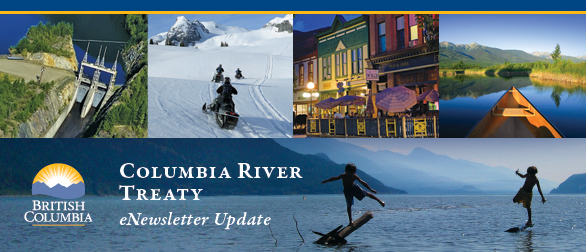Columbia River Treaty
Edition:

Columbia River Treaty Review
The Columbia River Treaty is a trans-boundary water management agreement between the U.S. and Canada that was signed in 1961 and ratified in 1964. One of the key principles of the Columbia River Treaty (Treaty) is to create and equitably share benefits resulting from the trans-boundary coordination.
Although the Treaty has no specified end date, either Canada or the U.S. can unilaterally terminate most of the agreement provisions as early as September 16, 2024, provided that at least 10 years notice is given (on or before September 16, 2014).
International treaties like the Columbia River Treaty are within the jurisdiction of the executive branch of the Federal Government; however the Canada-British Columbia Agreement (1963) transferred most treaty rights and obligations to the Province, and also requires the agreement of the Province before terminating the Treaty.
The primary purposes of the Treaty are to provide flood control in Canada and the U.S., and increase the power generating potential of the Columbia River by capturing spring run-off and releasing water at other times of the year when it is more valuable.
Under the Treaty, Canada agreed to build 15.5 million acre feet of storage behind three dams – Duncan, Arrow (now called Hugh Keenleyside) and Mica. The Treaty also gave the U.S. the option, which it exercised, to construct a dam near Libby, Montana, creating the Koocanusa Reservoir that floods the Kootenay River valley 68 km back into Canada almost as far as Cranbrook.
In 1964 Canada (British Columbia) received an upfront US$64M one-time payment for 60 years of flood control. This assured flood control provision expires in 2024 and changes to a more ad hoc “called-upon” version of flood control. Canada’s (British Columbia’s) share of U.S. downstream benefits were sold to the U.S. for the first 30 years from the scheduled completion date of each dam for US$254 million to help finance the construction of the Treaty dams.
Currently, the Treaty returns approximately $100 to 200 million each year to the Province’s Consolidated Revenue Fund through the sale of Canada’s share of the downstream power benefits in the U.S. (referred to as the Canadian Entitlement).
In Canada, BC Hydro is the “Entity” designated by Canada with the responsibility to implement the Treaty on behalf of the Province and Canada. The Province has been designated as the Canadian Entity for the purposes of disposing of the Canadian Entitlement. In the U.S., the Treaty is entirely the responsibility of the Federal government which has jointly designated officials from the Bonneville Power Administration and the U.S. Army Corps of Engineers as the U.S. Entity responsible for implementation.
Recently, government agencies in British Columbia, Canada and the United States have conducted separate reviews to evaluate future options, including continuation, amendment or termination of the Columbia River Treaty. The Ministry of Energy and Mines’ Columbia River Treaty Review Team led the provincial review. The provincial and federal governments worked together to ensure a coordinated and comprehensive approach to the Treaty Review, including First Nations consultation.
The Treaty Review Team completed four rounds of public consultation delivering 24 community events and an all-day technical conference. More than 1,000 Basin residents attended the events. The Treaty Review Team also established a cross-Basin advisory group of knowledgeable residents, attended regional youth and college events, and developed and delivered a classroom project that reached approximately 600 Basin students.
Basin residents were able to provide feedback throughout the consultation process, including on the draft provincial recommendation, principles and public consultation report, in person at community events and through email, blog posts, Facebook and Twitter. Basin residents generally agreed that they have been heard, that the public consultation report reflected, or mostly reflected, their issues, concerns and interests.
The Treaty Review Team consulted, on a government-to-government basis, the Ktunaxa, Shuswap and Okanagan nations who assert rights and title in the Columbia Basin. The Treaty Review Team also consulted with local and regional governments, federal agencies and stakeholder groups.
The Treaty Review outcome is majority stakeholder support for the Treaty Review Team recommendation to the Government of British Columbia to continue the Treaty and seek improvements.
On June 27, 2013, the U.S. Entity released working draft recommendations on the future of the Treaty. In September, a subsequent draft was released for further stakeholder and public comment, prior to final recommendations being made to the U.S. Department of State on December 13, 2013.
The United States will conduct a federal interagency review under the general direction of the National Security Council on behalf of the President in order to determine what, if anything, should be negotiated with Canada and British Columbia. That review is expected to be completed by late 2014.
The Treaty Review Team continues to seek to understand and evaluate U.S. interests and benefits, and has committed to engage with Columbia River Basin residents and First Nations throughout any negotiation process.

